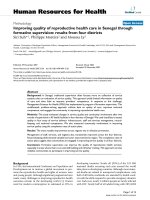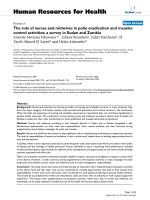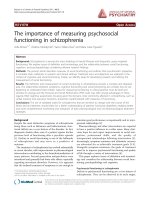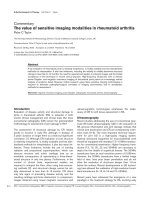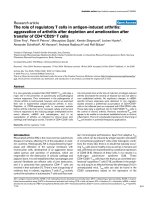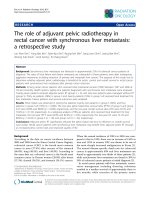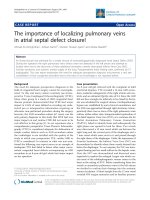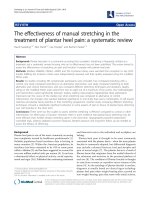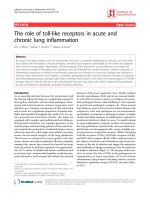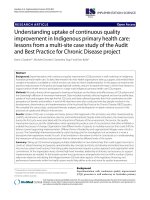Báo cáo y học: " The effectiveness of problem solving therapy in deprived South African communities: results from a pilot study" pps
Bạn đang xem bản rút gọn của tài liệu. Xem và tải ngay bản đầy đủ của tài liệu tại đây (210.46 KB, 8 trang )
RESEARCH ARTICLE Open Access
The effectiveness of problem solving therapy in
deprived South African communities: results from
a pilot study
Edith van’t Hof
1,2*
, Dan J Stein
1
, Isaac Marks
3
, Mark Tomlinson
4
and Pim Cuijpers
2
Abstract
Background: The majority of South Africans with a DSM-IV diagnosis receive no treatment for their mental health
problems. There is a move to simplify treatment for common mental disorders (CMDs) in order to ease access.
Brief problem solving therapy (PST) might fill the treatment gap for CMD’s in deprived communities in South
Africa. This pilot study evaluates the feasibility, acceptability and effectiveness of this PST program for CMD’sin
deprived communities around Cape Town.
Methods: A Dutch problem solving program was adapted and translated into English, Xhosa and Afrikaans and
thereafter implemented in townships around Cape Town. An initial attempt to recruit participants for online PST
proved difficult, and so the program was adapted to a booklet format. Volunteers experiencing psychological
distress were invited to participate in the either individually or group delivered 5-week during self-help program.
To evaluate the effectiveness, psychological distress was administered through self-report questionnaires. After
completion of the intervention participants also rated the program on various acceptability aspects.
Results: Of 103 participants, 73 completed 5 weeks of brief PST in a booklet/workshop format. There were
significantly more dropouts in those who used the booklet individually than in the group. Psychological distress
measured on the K-10 and SRQ fell significantly and the program was evaluated positively.
Conclusions: The results suggest that brief problem solving in a booklet/workshop format may be an effective,
feasible and acceptable short-term treatment for people with CMD’s in deprived communities. In this setting,
group delivery of PST had lower drop-out rates than individual delivery, and was more feasible and acceptable.
Randomized controlled trials are needed to evaluate the effect of brief self-help PST more rigorously.
Background
Common mental disorders are very prevalent and signif-
icantly impact the lives of many people in low-and mid-
dle-income countries, including South Africa. A
nationally representative study revealed that 30% of
South African adults had a DSM-IV disorder in their
lifetime, including 16% with an anxiety disorder and
10% with a mood disorder [1]. Depression and anxiety
disorders can be chronic [2], s everely impair quality of
life [3], cause excess mortality [4], and incur substantial
societal costs [5]. In South Africa, psychiatric disorders
were ranked as the third most disabling condition, after
HIV/AIDS and other infectious diseases [6], wh ile many
HIV/AIDS sufferers had comorbid mental disorders [7].
Despite this high prevalence of common mental disor-
ders, many who suffer from these conditions do not
receive treatment. In a recent survey, only a quarter of
SouthAfricanswitha12-monthDSM-IVdiagnosisof
anxiety or depression had been treated in the preceding
year [8,9]. This is unsurprising as there are many bar-
riers to treatment, including the fact that resources are
inadequate and unevenly distributed across the country
[9-13]. Most services are l ocat ed in the urban areas and
are still cha racterized by patterns created by racial seg-
regation and inequities during the apartheid system
[14,15]. The integration of mental health care into pri-
mary care facilities has been said to lack behind due to
* Correspondence:
1
Department of Psychiatry and Mental Health, University of Cape Town,
Cape Town, South Africa
Full list of author information is available at the end of the article
van’t Hof et al. BMC Psychiatry 2011, 11:156
/>© 2011 van’t Hof et al; licensee BioMed Central Ltd. This is an Open Access article distributed under the te rms of the Creative
Commons Attribution License (http ://creativecommons. org/licenses/by/2.0), which permits unrestricted use, distribution, and
reproduction in any medium, provided the original work is properly cited.
primary care nurses’ large workloads and lack in mental
health training [16].
The number of people with mental health problems
receiving no treatment is 30-50% in high income coun-
tries and 76-80% in low-and middle income countries
(LAMICs) [17]. The World Health Organization (WHO)
notes that this treatment gap is mainly due to a scarcity
of human, mental health and financial resources which
are also caused by policies in LAMIC. Many people who
seek help are not treated with evidence-based interven-
tions [18]. Socio-economic status determines access to
facilities, creating a huge inequity in access to me ntal
health care in most low and middle-income countries
[19]. The WHO has called for increased inve stment in
mental health research, particularly in LAMIC [20] and
the scaling up of services [21]. Research can reinforce
the commitment of policymakers and provide a concrete
evidence-based programme to upscale care for mental
disorders and to reduce the treatment gap for mental
disorders in LAMIC.
Researchers are currently investigating the develop-
ment of easily accessible, evidence-based, and cost-effec-
tive treatments. Self-help problem solving therapy (PST)
could be one such approach. Guided-self help has had
promising efficacy in an xiety disorders [22-24] , unipolar
depression [24-27], alcohol addiction [28], sexual dys-
function [29], weight loss [29], and phobias [30]. PST
self-help can be guided face to face or by book, phone,
interactive voice response, CD-ROM, television, video or
the Internet. PST is a cognitive behavioural therapy
(CBT) technique which is applicable in primary care
[31] and cost-effective in treating common mental
health problem s [32-37] . It assumes that depression and
anxiety symptoms are often caused by practical everyday
problems and aims to teach people better ways to cope
with such problems by setting goals and minimizing
feelings of incompetence and distress [38]. P ST can be
sensitive to local needs, is efficacious for depression
[32-37] and anxiety and emotional disorders [39,40], is
well-established in developed world settings and requires
fairly limited resources.
PST is thus a good candidate to narrow the treatment
gap for mental disorders in South Africa. However, data
on psychotherapies from high-income countries may
not be generalisable to LAMICs [41]. First, cultural fac-
tors can influence the conceptualization of common
mental disorders by both patient and care providers.
The attitudes of people in developed and developing
countries often differ regarding the kind of help needed
to resolve a disorder. Explanatory models in many low
and middle-income countries may be less likely to
acknowledge psychobiological factors in psychological
distress. This may affect attitudes regarding the kind of
help needed and the acceptability of mental health
interventions. Second, the infrastructure of health sys-
tems across countries can diverge extensively. The
applicability of t reatment research from developed to
LAMIC countries can be influenced by the scarcity of
mental health manpower, the growth of the private
medical sector, rising health costs, a nd changing health
care financing systems [41].
This pilot study aimed to adap t and test the fe asibility
and acceptability of low-cost PST in South African com-
munities which have little or no access to mental health
services. Our original implementation used a web-
guided format of PST in different deprived communities
around Cape Town. We found that the lack of access to
a computer and the Internet and the lack of basic com-
puter and Internet literacy among community members
probably played a role in the poor take-up of our web-
guided program, making it difficult to implement a web-
guided intervention. When the recruitment of online
PST users proved difficult we adapted the PST to a
booklet format to see if this was more feasible and
acceptable. Why online PST wasn’t feasible and accepta-
ble in South African communities is discussed in more
detail in a previous paper [42]. After deliberation with
local community workers , we converted the online PST
content to a booklet-plus-workshop PST version and
evaluated its use. This paper presents the pilot results
using the booklet and workshop version in deprived
Cape Town communities.
Methods
Development of the intervention
The Dutch PST (Problem Solving Therapy) website
‘ Allesondercontrole.nl’ was translated into English,
Xhosa and Afrikaans, the three official languages spoken
in South Africa’s Western Cape Province. The accuracy
of the translations was checked by back-translating the
English version (called ‘Taking control’)andAfrikaans
version (called ‘ Vat beheer’) into Dutch and the Xhosa
version (called ‘Lawula ubomi bakho’ ) into English. A
team of experts adapted the case vignettes to make
them relevant to our population by identifying three
themes of major relevance: HIV/AIDS, unemployment,
and trauma due to violence. Three comprehensive clini-
cal vignettes were constru cted around these site-specific
topics and were reviewed by South African experts in
psychology, psychiatry and social work.
Recruitment of participants
After fieldwork and visits to several communities, we
offered booklet PST in various communities with limited
access to mental health care. Recruitment was by: post-
ing pamphlets and posters on notice boards of commu-
nity libraries, community centres and public health
facilities and by giving short talks on the program in
van’t Hof et al. BMC Psychiatry 2011, 11:156
/>Page 2 of 8
community settings. These recruitment methods drew
very few participant s, so we worked with local non-gov-
ernmental organisations (NGOs) to refer people to our
program. The NGOs gathered people to attend short
talks about the project by the project manager and assis-
tants in English, Xhosa or Afrikaans.
We recruited people from 4 different communities
representing deprived communities around Cape Town
with lack of access to mental health care. The first,
Langa, is a black township with mostly formal housing
which was established in 1923. Khayeltisha, another
black township, is a much younger, urbanizing, mainly
post-apartheid township whose housing is mostly infor-
mal. The third is a coloured township named Manen-
berg - created by the apartheid government in 1966 and
1970 for low-income coloured families. It has mixed for-
mal and informal housing. In order to study a rural
community as well, we included Mamre - 60 km from
Cape Town - which was founded as a Mor avian mission
station in 1808 and is a rural village with housing
mainly consisting of small cottages.
Volunteers at each site were invited to participate if
they felt they had mental health problems. They were
excluded if they : 1. had suicide plans, rather than just
suicidal thoughts; 2. had severe mental health problems
- such patients were referred to their local community
day hospital, in line with the Western Cape’smental-
health-referral guidelines; 3. were too illiterate to read
the booklet’ s self-help text in English, Afrikaans or
Xhosa.
The Intervention
An initial attempt to recruit participant s for online PST
proved difficult, and so the program was adapte d to a
booklet format. The adapted Dutch self-help Problem
Solving Therapy called “Alles onder controle” (’Taking
control’ ) is based on the self-examination therapy of
Bowen et all [43]. In ‘’self-examination therapy’’ subjects
learn to take control of their problems and their lives by
(1) determining what really matters to them, (2) invest-
ing energy solely in problems related to what matters,
(3) thinking less negatively about the problems which
are unrelated, and (4) accepting situations that cannot
be changed. It was developed as a self-help booklet
which proved efficacious in several studies [43,44].
’ Taking control’ consists of three steps: 1. describe
what really matters to you in life; 2. write down current
worries and problems and sort them into three cate-
gories: (a) unimportant problems (unrelated to things
that matter), (b) soluble problems, and (c) insoluble pro-
blems (e.g., the loss of a loved one). For unimportant
problems techniques to cope with negative thoughts are
suggested (worry time, thought stopping, log of positive
thoughts). Insoluble problems are addressed by
explaining the natural course of coping processes and
tips on how to speed acceptance (e.g., accepting negative
feelings, talking with other people and establishing con-
tact with others in a similar situation). Soluble problems
are addressed i n six steps: i) describe the problem, ii)
brain-storm solutions, iii) choose the best solution, iv)
make a plan for carrying out the solution, v) actually
carryoutthatsolution,vi)evaluatetheresults.Coping
with traumatic experiences is managed by explaining
techniques to help the coping process (putting into
words, impact statement, wor k through e motions,
reconnect). In the last (3
rd
) step, subjects are asked to
draw up a plan for the future describing how they
would try to accomplish the things that matter most to
them. The booklet also contains vignettes of people
using the PST techniques to solve their problems and
their homework assignments over five weekly lessons.
Format of the intervention
The pilot study tested ‘Taking control’ as a booklet.
Subjects in the individual format were asked to work
through the booklet on their own for 5 weeks by read-
ing the weekly materials. Over the five weeks they were
offered weekly brief phone support by trained coaches
in their own language. The coaches were a psycholo gist
(au thor EH) and a clinical psychology graduate working
on the project, both trained by author PC. The coaches
used a str uctured one-page instruction template to
guide participants through the process, and noted the
call’s content and i ts duration. Participants could text a
free ‘please call me’ message to their coach saying when
they could receive the weekly support phone call.
Due to a high drop-out rate with individual therapy,
difficulties reaching participants, and needs expressed by
participants, we tried instead to deliver the ‘Taking Con-
trol’ book to volunteers in groups which met weekly for
45-60 minutes over 5 weeks. Each group had 6-15 mem-
bers. During group sessions members were given t he
next week’schapterof‘Taking control’ and were guided
regarding problems and homework difficulties encoun-
tered with the previous chapter. Members were asked to
read, between sessions, the relevant part of the book
and complete its associated homework assignments. In
group meetings members shared their experiences on
how to deal with problems and worries. They could get
the same phone support between sessions as subjects
who used the book individually.
Whether people used the book individually or in a
group depended on time of enrolment in the study and
accessibi lity to group meetings. After the switch to deli-
vering the book in groups most new volunteers opted
the group format, though subjects still had the choice of
going through the book individually. When assigning
people to g roups no active ma tching took place f or
van’t Hof et al. BMC Psychiatry 2011, 11:156
/>Page 3 of 8
language, cultural b ackground or gender. Since the
groups mostly contained people from a specific commu-
nity participant were very similar in cultural background
and language.
Data collection
Prior to the intervention, participants completed a ques-
tionnaire concerning demographic variables (age, gen-
der, education, marital sta tus, occupation, ethnic
background, number of children, first language, religion,
living location) and current mental health problems.
The Kessler Psychological Distress Scale (K-10), Self
Reporting Questionnaire for mental he alth symptoms
(SRQ) and the Boston University Empowerment Scale
(BUES) were administered before session 1 and after
session 5 to evaluate the effect on mental health symp-
toms. The K-10, SRQ and BUES were translated from
English into Xhosa and Afrikaans by a back-translation
process. After session 5 participants also rated ‘Taking
Control’ for acceptability, satisfaction, credibility, length
and format, ease of reading, and content. The ‘accept-
ability and feasibility questionnaire’ was developed by
the team to elicit attitudes of the participants towards
specific elements of the intervention. Participants had to
indicate their level of agreement on 12 statements about
the intervention (as reported in Table 1) using a 5 point
likert scale. The last 4 questions of the questionnaire
evaluate the participants’ perceptio n of helpfulness of
different group and content aspects of the i ntervention
(as reported in Table 2).
Data analyses
The differences in pre and post scores were evaluated by
t-test. We obtained maximum-likelihood estimators for
our missing data using the Expectation-Maximization
(EM) algorithm, and did t-tests after imputing missing
data. We used c
2
statistics to evaluate associations
between categorical variables and an ANCOVA to
detect changes in effect for individually- and group-
delivered ‘ Taking Control’ . Finally, we did Wilcoxon
testing of the difference between the number of people
falling into various K-10 categories before and after the
intervention.
Results
Participants
A total of 103 subjects partici pated in the study, 57 in
its individual format and 46 in its group format. The
mean age of people who enrolled in the PST program
was 37; 22% we re male; 29% were black Africans and
71% coloured (mixed race). Most lived in Manenberg
(58%) and Khayelitsha (21%), 90% were unemployed and
46% were married. Regarding education, 6% had finished
higher education, 22% had finished high school, and
33% had not finished primary school. When asked what
kind of mental health problems were present the most
commonly mentioned were: being stressed (72%),
Table 1 Evaluation of the program; percentage of people in different answer categories
Response range (1-5) Strongly disagree Disagree Undecided Agree Strongly agree Response average
Language used is understandable - - 22 24 53 4.3
Book is easy to read 2 8 44 45 4.3
Stories apply to my problem 2 6 29 34 29 3.8
Case stories are useful 1 6 7 31 56 4.3
Homework was useful - 2 9 52 37 4.2
Advice on solving problems helped a lot 1 8 50 42 4.3
Advice on solving problems apply to my problems 1 6 33 28 33 3.9
Advice on 3 problems was useful 1 1 13 44 40 4.2
Book helped me to overcome depression/anxiety 2 2 8 28 60 4.4
I would recommend this book 1 1 2 36 60 4.5
Total respondents 90
Table 2 Percentages of people agreeing and disagreeing
on the helpfulness of specific components of the
intervention
N = 27 %
Yes
%
No
Content treatment:
Learning ways to cope with negative feelings 82 18
Learning to solve problems in 6 steps 67 33
Learning ways to cope with trauma 52 48
Learning ways to cope with loss or life changing
event
60 40
Group dynamics
Feeling understood by others 60 40
Chance to help others 52 48
Feeling accepted and valued 70 30
Creating hope by seeing other people overcome
problems
67 34
van’t Hof et al. BMC Psychiatry 2011, 11:156
/>Page 4 of 8
worrying a lot (29%), being depressed (23%), being sad
(16%) and thinking too much (12%). The baseline K10
scores indicated that 9% of our participants scored low,
22% moderate, 43% high and 26% very high. (Table 3)
Of the 103 participants, 73 completed ‘ Taking Con-
trol’ . Completion was not significantly associated with
sex, marital status, age, employment or education. There
were significantly more dropouts in those who used the
book individually (44%, n = 25/57) than in the group
(11%, n = 5/46); c
2
(1) = 13.4, p < .001; (OR = 6.5, 95%
CI: 2.2-18.6) . There was no diff erence in age with
between people who finished and dropped out (t (98) =
0.14, p > .05.
There was a significant association between dropout
rate and living location and both living location (c
2
(2)
= 6.53, p < .05) and ethnic group (c
2
(3) = 12.235, p <
.01). The odds of people dropping out were h igher for
people living in KhayelitshathaninManenberg(OR=
2.9, Cl: 0.94 - 8.81). The odds of people dropping out
was higher for people from a Xhosa than Coloured
background (OR = 1.8, Cl: 0.66 - 5.1).
Effectiveness of the intervention
Analyses of just completers found that mental health
symptoms fell significantly from before to after using
‘Taking Control’ on both the K10 (pre: M = 20. 33, SE =
7.14; post: M = 25,79, SE = 7.48, t (72) = 6.87, p < 0.05,
d = 0.63) and on the SRQ (pre: M = 5.59, SE = 4.77;
post:M=7.25,SE=4.93,t (31)=2.041,p=0.05,d=
0.34). Participants reported being significantly more
empowered on the BUES post (M = 50.21, SE = 5.28)
than pre-participation (M = 47.86, SE = 4.67), t (36) =
-2.361, p < 0.05, d = 0.43 (Table 4). Intent-to-treat ana-
lyses after imputing missing data did not reveal different
results (Table 4). An ANCOVA showed no significant
effect of individual versus group format of delivery on
the post K-10 scores after controlling for the K10 pre
scores F(1,70) = 2,26, p = 0.137. Table 3 shows the
number of participants in each K10 category, with an
obvious reduction in percentages in the high and very
high categories after the intervention. There was a sig-
nificant decrease in participants in the ‘very high’ cate-
gory (p = 0.005), and the ‘high’ category (p = 0.011).
The number of participants in the ‘ low’ category
increased significan tly (p < 0.001) and in the ‘ mi ld’
group tended to increase (p = 0.131).
Evaluation of program
Halfway through recruitment the high drop-out rate
(44%), difficulties in reaching participants and feedback
on their individual use of ‘Taking Control’ showed a
need to switch to its use in groups. Difficulties in reach-
ing participants on cell phones also made it harder to
give weekly coaching support by phone. Many preferred
face-to-face support. A strong preference for sessions in
groups were expressed by participants going through
‘Taking Control’ individually and by people attending
recruitment talks for our project. To meet the needs of
those receiving treatment we therefore s witched to try-
ing out the group format.
The aspects of ‘Taking Control’ which participants
regarded as most helpful were ‘ learning to cope with
negative feelings’ (82%), ‘ feeling accepted and valued’
(70%), ‘learning to solve problems in six steps’ (67%)
and ‘ creating hope by seeing other people overcome
problems’ (67%). Table 2 shows the percentages of ‘yes’
and ‘ no’ answers on the remaining questions. The
Table 3 Pre-post test differences K10 categories
N=73 Pre % Post % p-value
Low (1-15)
may currently not be experiencing significant feelings of distress.
8.9 31.5 0.001
Moderate (16-21)
experiencing mild levels of distress consistent with a mild depression or anxiety disorder
22.8 31.5 0.131
High (22-30)
experiencing moderate levels of distress consistent with a moderate depression or anxiety disorder
42.6 26 0.011
Very high (30-50)
experiencing severe levels of distress consistent with a severe depression or anxiety disorder
25.7 11 0.005
Table 4 Pre-post differences on measures from analyses
on completers only and imputed data analyses
Completers only
Pre Post Comparison pre-post
Mean SE Mean SE Mean Drop Effect size p<
K-10
n=73
25.79 7.48 20.33 7.14 5.46 0.63 0.001
SRQ
n=32
7.25 4.93 5.59 4.77 1.66 0.34 0.05
BUES
n=37
47.86 4.67 50.13 5.28 -2.27 0.43 0.024
Intent to treat
K-10
n = 103
25.34 7.5 20.08 6.40 5.26 0.66 0.001
SRQ
n=49
7.16 4.01 5.69 3.95 1.47 0.37 0.001
BUES
n=49
48.36 5.55 50.23 4.78 -1.87 0.31 0.025
van’t Hof et al. BMC Psychiatry 2011, 11:156
/>Page 5 of 8
percentages of people feeling helped ‘alot’ or ‘an enor-
mous amount’ were 73% for ‘being part of a group’ and
64% for ‘the content of the intervention’.
The great majority of the p articipants rated the ‘ Tak-
ing Control’ booklet as ea sy to read (89%) a nd its lan-
guage understandable (77%) (Table 1). M any found the
case studies (78%) and homework assignments (89%)
useful components of the program. ‘Taki ng Control’’s
focus on problem solving was rated as helpful by 92% of
participants and the distinction between 3 different
types of proble ms was said to be useful by 84%. A large
majority of participants saidthecoursehelpedthem
with their feelings of depression, distress and anxiety
(88%) and almost all would recommend the course to
others (96%). However, a substantial number felt that
the examples did not show how to solve problems (39%)
and the case studies portrayed (37%) were not applicable
to their problems. Suggestions for which problems
deserved more guidance within ‘Taking Control’ were;
not being excepted in the community due to homosexu-
ality, and drug abuse and violence at home.
Discussion
This pilot studied the feasibility, acceptability and effec-
tiveness of ‘ Taking Control’ ,abookletguidiedbrief
short-term problem solving therapy (PST) for people
with mental health problems in deprived communities
around Cape Town. In these communities the ap proach
was feasible and acceptable. We found a higher drop-
out in the individual format than in the group delivery
format. Mental health symptoms improved significantly
over the 5 weeks of the PST. Participants’ sense of
empowerment i ncreased as they adopted solutions sui-
ted to the local c ontext and skills to enhance control of
their lives.
In our communities group delivery of PST had lower
drop-out rates than individual delivery, and was more
feasible and acceptable. Participants said non-specific
group factors like altruism (chance to help others), uni-
versality (feeling understood and similar to others) and
cohesion (feeling accepted and valued) were as helpful
as the content of the book. We did not, however, find a
significant difference in improvements between group
and individual delivery of ‘Taking Control’ in our pilot.
Non-specific factors like therapeutic alliance, providing
a rationale for the symptoms and healing setting have
an effect on both group and individual formats of the
intervention. Group interventions have additional non
specific factors, which could influence the effect of an
intervention. Previous findin gs indicate t hat specific as
well as non-specific therapy factors can yield similar
improvement [45,46]. More research is needed to iden-
tify and evaluate the actual active components in PST
programmes. This will contribute to the identification of
potential components to focus on in strengthening the
intervention.
Of course our pilot study has the limitations of a
small sample size, absence of a control group , and non-
random assignment to group or individual use of the
‘Taking Control’ booklet. The i mprovement and sense
of empowerment might have resulted from spontaneous
remission or placebo effects. After 5 weeks of participa-
tion there was no further follow up to check sustainabil-
ity of the results.
In a recent Indian study individually delivered brief
problem solving was not more effective than placebo for
people with common mental disorders [47]. The authors
considered that insufficient structure of the therapy and
the fact that their primary care patients thought and
expected that they should receive medication might
have been reasons for finding no effect. Ano ther pro-
blem was poor adherence to their problem solving inter-
ventions. The problem solving sessions were delivered
individually and took place in clinics, which differs from
our use of group session in community settings. The
poor adherence rate might be an indication for low
acceptability of the treatment in the research population
and another reason for finding no effect. They authors
remark that many problems people face in low and mid-
dle income countries are embedded in social problems
so a purely clinical program may be insufficient to bring
relief [48].
The results of our pilot fit with a growing literature on
mental health care in low and middle income countries
attempting to determine the best mode and type of
mental health treatment in these settings. An increasing
number of studies show the potential of group interven-
tions for mental disorders in L AMICs. Bolton et al
found that group interpersonal psychotherapy was fe asi-
ble and effective in treating depressive symptoms in
Ugandan adults and adolescents [49-51]. A Chilean psy-
cho-educational group intervention was effective in
reducing depressive symptoms in women [52]. In Iran,
group CBT was superior to fluoxetine in treating
depr ession and a nxiety of infertile women [53]. In addi-
tion, group based interventions were effective in control-
ling birth outcomes and maternal depression in India
and Nepal [54,55]. An often mentioned possible a dvan-
tage of group over individual treatment is cost-effective-
ness. A recent review did not, however, find evidence of
group CBT being more cost-effective than individual
CBT [56]. Group psychotherapy was cost-effective in the
LAMIC Uganda [57] and a primary stepped-care pro-
gram for depressed women in Chile was significantly
more effective and only slightly more expensive than
care as usual [58].
There are, however, still relatively few studi es showing
the feasibility and efficacy of group interventions in
van’t Hof et al. BMC Psychiatry 2011, 11:156
/>Page 6 of 8
LAMIC. Many cultural, politic al, economic and socia l
differences may limit the generalizability of these stu-
dies. More randomised controlled trials are needed of
group versus individual delivery in such low-income
communities, a nd stepped care prog rams. Although the
studies conducted had promising results, the accept abil-
ityofgroupinterventionsinmanyLAMICsisstill
unclear. Traditionall y many f ind it inappropriate t o dis-
cuss personal details with people outside the family, and
this could complicate the use of such group of treat-
ments [48]. The feasibility and cost-effectiveness of
group PST should be studied by implementing the inter-
vention in primary care facilities with lay workers as
group facilitators. In this way the cost can be minimized
and b e compared to the care as usual costs made when
people present themselves with CMD’s in primary care
clinics.
The encouraging results of the present pilot study
suggestthatitisworthstudyingfurtherapplicationsof
group PST to reduce the burden of common mental dis-
orders in deprived communities. The intervention was
sensitive to local needs, fostered active coping styles and
all owed for indigenous solu tions suited to the local cul-
tural context. However, some adaptations should be
considered in future testing of our ‘Taki ng Control’ pro-
gram . More group sessions might be needed after parti-
cularly severe o r numerous traumas. Locally prominent
problem s such as drug abuse, not being accepted in the
community due to homosexuality, and violence need to
be addressed in more de tail. Our coaches were a trained
psychologist and a psychology student, but PST con-
ducted by non-professionals has been effective [36,40].
So further work is needed to see if PST can be task-
shifted away from a psychologist and to trained lay peo-
ple, making it more feasible to integrate in primary
health care or other consisting care structures. The high
prevalence of mental disorders in deprived communities
emphasizes the potential value of low-cost interventions
and task-shifting.
Conclusion
The results suggest that brief problem solving in a book-
let/workshop format may be an effective, feasible and
acceptable short-term treatment for people with CMD’s
in deprived communities. In this setting, group delivery
of PST had lower drop-out rates than individual deliv-
ery, and was more feasible and acceptable. Randomized
controlled trials are, however, needed to test the efficacy
and cost-effectiveness of group PST more rigorously
and to justify its future scaling up in LAMIC.
Acknowledgements
Authors received funding from SANPAD (grant number 07/37). SANPAD had
no involvement in study design, in the collection, analysis, and interpretation
of data, in the writing of the report or in the decision to submit the paper
for publication. The authors would like to give thanks to Winnie Gae,
Bulelani Futshane, Self Help Manenberg and Umtha Welanga for their
involvement in recruiting participants and carrying out the project.
Author details
1
Department of Psychiatry and Mental Health, University of Cape Town,
Cape Town, South Africa.
2
Department of Clinical Psychology, VU University
Amsterdam, Amsterdam, The Netherlands.
3
Institute of Psychiatry, King’s
College London, London, UK.
4
Department of Psychology, University of
Stellenbosch, Stellenbosch, South Africa.
Authors’ contributions
All authors contributed to the study design. EH carried out the data
collection. EH, PC and DS undertook the data-analyses. EH wrote the first
draft of the manuscript with authors PC, DS, IM and MT contributing to data
interpretation and providing critical reading of the manuscript. All authors
contributed to and have approved the final manuscript.
Competing interests
The authors declare that they have no competing interests.
Received: 21 April 2011 Accepted: 30 September 2011
Published: 30 September 2011
References
1. Stein D, Seedat S, Herman A, Moomal H, Heeringa S, Kessler R, Williams D:
Lifetime prevalence of psychiatric disorders in South Africa. The British
Journal of Psychiatry 2008, 192:112-117.
2. Spijker J, de Graaf R, Bijl RV, Beekman AT, Ormel J, Nolen WA: Duration of
major depressive episodes in the general population: results from The
Netherlands Mental Health Survey and Incidence Study (NEMESIS). British
Journal of Psychiatry 2002, 181:208-213.
3. Beekman A, Penninx B, Deeg D, de Beurs E, Geerings S, van Tilburg W: The
impact of depression on the well-being, disability and use of services in
older adults: a longitudinal perspective. Acta Psychiatr Scand 2002,
105:20-27.
4. Cuijpers P, Smit F: Excess mortality in depression: a meta-analysis of
community studies. Journal of Affective Disorders 2002, 72:227-236.
5. Smit F, Cuijpers P, Oostenbrink J, Batelaan N, de Graaf R, Beekman A: Excess
costs of common mental disorders: population-based cohort study.
Journal of Mental Health Policy and Economics 2006, 193-200.
6. Bradshaw D, Norman R, Schneider M: A clarion call for action based on
refined DALY estimates for South Africa. South African Medical Journal
2007, 97:438-440.
7. Bradshaw D, Schneider M, Dorrington R, Bourne D, Laubscher R: South
African cause-of-death profile in transition–1996 and future trends.
South African Medical Journal 2002, 92:618-623.
8. Seedat S, Stein D, Herman A, Kessler R, Sonnega J, Heeringa S, Williams S,
Williams D: Twelve-month treatment of psychiatric disorders in the
South African Stress and Health Study (World Mental Health Survey
Initiative). Social Psychiatry and Psychiatric Epidemiology 2008, 43:889-897.
9. World Health Organisation: World Health Organisation (2005) Atlas: mental
health resources in the world 2005 Geneva: World Health Organization; 2005.
10. Lund C, Flisher A: Staff-bed and staff-patient ratios in South African
public sector mental health services. South African Medical Journal 2002,
92:157-161.
11. Lund C, Flisher A: Staff-population ratios in South African public sector
mental health services. South African Medical Journal 2002, 92:161-164.
12. Lund C, Flisher A: Norms for mental health services in South Africa. Social
Psychiatry and Psychiatric Epidemiology 2006, 41:594.
13. Lund C, Stein D, Flisher A, Mehtar S: Challenges faced by South African
health services in implementing the Mental Health Care Act. South
African Medical Journal 2007, 97:352-353.
14. Flisher A, Ricctelli G, Jhetam N, Robertson B: A survey of professional
activities of psychiatrists in South Africa. Psychiatric Services 1997,
48:707-809.
15. Pillay A: Developing community mental health services for children in
South Africa. Soc
Sci Med 1997, 45:1493-1501.
16. Emsley R: Focus on psychiatry in South Africa. British Journal of Psychiatry
2001, 178:382-386.
van’t Hof et al. BMC Psychiatry 2011, 11:156
/>Page 7 of 8
17. World Health Organisation: mhGAP:Mental Health Gap Action
Programme: scaling up care for mental, neurological and substance use
disoders. 2008.
18. Saxena S, Thornicroft G, Knapp M, Whiteford H: Resources for mental
health: scarcity, inequity, and inefficiency. The Lancet 2007, 370:878-889.
19. Kohn R, Saxena S, Levav I, Saraceno B: The treatment gap in mental
health care. Bulletin of the World Health Organization 2004, 82:858-866.
20. World Health Organisation: Investing in Mental Health Geneva; 2003.
21. World Health Organisation: Mental Health Gap Action Plan: scaling up care
for mental, neurological and substance use disorders Geneva: WHO Press;
2008.
22. Hirai M, Clum G: A meta-analytic study of self-help interventions for
anxiety problems. Behav Ther 2006, 37:99-111.
23. Cuijpers P, Schuurmans J: Self-help interventions for anxiety disorders: an
overview. Curr Psychiatry Rep 2007, 9:284-290.
24. den Boer P, Wiersma D, van den Bosch R: Why is self-help neglected in
the treatement of emotional disorders? A meta-analysis. Psychological
Medicine 2004, 34:959-971.
25. Cuijpers P: Bibliotherapy in unipolar depression: a meta-analysis. J behav
ther & Exp Psychiat 1997, 28:139-147.
26. Spek V, Cuijpers P, Nyklicek I, Riper H, Keyzer J, Pop V: Internet-based
cognitive behaviour therapy for symptoms of depression and anxiety: a
meta-analysis. Psychological Medicine 2007, 37:328.
27. Anderson L, Lewis G, Araya R: Self-help books for depression: how can
practitioners and patients make the right choice? Br J Gen Pract 2005,
55:387-392.
28. Apodaca T, Miller W: A meta-analysis of the effectiveness of bibliotherapy
for alcohol problems. J Clin Psychol 2003, 59:289-304.
29. Marrs R: A meta-analysis of bibiliotherapy studies. American Journal of
Community Psychology 1995, 23:843-870.
30. Scogin F, Bynum J, Stephens G, Calhoon S: Efficacy of self-administered
treatment programs: meta-analytic review. Profess Psychol Res Pract 1990,
21:42-47.
31. Mynors-Wallis L: Problem-Solving Treatment for Anxiety and Depression: a
practical guide Oxford; 2005.
32. Cuijpers P, van Straten A, Warmerdam L: Problem solving therapies for
depression: A meta-analysis. European Psychiatry 2007, 22:15.
33. Mynors-Wallis L, Gath D, lloyd-Thomas A, Tomlinson D: Randomised
controlled trial comparing problem solving treatment with amitryptiline
and placebo for major depression in primary care. British Medical Journal
1995, 310:441-445.
34. Mynors-Wallis L, Gath D, Day A, Baker F: Randomised controlled trial of
problem solving treatment, antidepressant medication, and combined
treatment for major depression in primary care. British Medical Journal
2000, 320:2630.
35. Arean P, Perri M, Nezu A, Schein R, Christopher F, Joseph T: Comparative
effectiveness of social problem-solving therapy and reminiscence
therapy as treatment for depression in older adults. Journal of Consulting
and Clinical Psychology 1993, 61:1003-1010.
36. Dowrick C, Dunn G, Ayuso-Mateos J, Dalgard O, Page H, Lehtinen V,
Casey P, Wilkinson C, Vazquez-Barquero J, Wilkinson G: Problem solving
treatment and group psycho-education for depression: multi-centre
randomised controlled trial. British Medical Journal 2000, 321:1-6.
37. Bell A, D’Zurilla T: Problem-solving therapy for depression: A meta-
analysis. Clinical Psychology Review 2009, 29:348-353.
38. Mynors-Wallis L: Problem-solving treatment in general psychiatric
practice. Advances in Psychiatric Treatment 2001, 7:417-425.
39. Catalan J, Gathe dAPBS, Day A, Hall L: Evaluation of a brief psychological
treatment for emotional disorders in primary care. Psychological Medicine
1991, 21:1013-1018.
40. Mynors-Wallis L, Davies I, Gray A, Barbour F, Gath D: A randomised
controlled trial and cost analysis of problem-solving treatment for
emotional disorders given by community nurses in primary care. British
Journal of Psychiatry 1997, 170:113-119.
41. Patel V: The need for treatment evidence for common mental disorders
in developing countries. Psychological Medicine 2000, 30:743-746.
42. van’t Hof E, Stein D, Marks I, Tomlinson M, Cuijpers P: Barriers to
implementing a web-guided intervention in low resourced communities:
lessons from a South African pilot study. 2011, under review JMIR.
43. Bowman D, Scogin F, Lyrene B: The efficacy of Self-Examination Therapy
and Cognitive Bilbiotherapy in the treatment of mild to moderate
depression. Psychotherapy Research 1995, 5:131-140.
44. Bowman D, Scogin F, Floyd D, Patton E, Gist L: Efficacy of self-examination
therapy in the treatment of generalized anxiety disorder. Journal of
Counseling Psychology 1997, 44:267-273.
45. Oei T, Shuttlewood G: Comparison of specific and nonspecific factors in a
group cognitive therapy for depression. J behav ther & Exp Psychiat 1997,
28:221-231.
46. Martin D, Garske J, Davis M: Relation of the therapeutic relation with
outcome and other variables. Journal of Consulting and Clinical Psychology
2000, 68:438-450.
47. Patel V, Chisholm D, Rabe-Hesketh S, Dias-Saxena F, Andrew G, Mann A:
Efficacy and cost-effectiveness of drug and psychological treatments for
common mental disorders in general health care in Goa, India: a
randomised, controlled trial. Lancet 2003, 361:33-39.
48. Patel V, Weiss H, Mann A: Predictors of outcome in patients with
common mental disorders receiving a breif pychological treatment: an
exploratory analysis of a randomized controlled trial from Goa, India.
Arch Gen Psychiatry 2010, 13:291-296.
49. Verdeli H, Clougherty K, Bolton P, Speelman L, Ndogoni L, Bass J,
Neugebauer R, Weissman M: Adopting group interpersonal
psychotherapy for a developing country: experience in rural Uganda.
World Psychiatry 2003, 2:114-120.
50. Bolton P, Bass J, Neugebauer R, Verdeli H, Clougherty K, Wickramaratne P,
Speelman L, Ndogoni L, Weissman M: Group interpersonal psychotherapy
for depression in rural Uganda: a ramdomized controlled trial. JAMA
2003, 289:3117-3124.
51. Bolton P, Bass J, Betancourt T, Speelman L, Onyango G, Clougherty K,
Neugebauer R, Murray L, Verdeli H: Interventions for depression
symptoms among adolescent survivors of war and displacement in
northern Uganda: a randomized controlled trial. JAMA 2007, 298:519-527.
52. Araya R, Rojas G, Fritsch R, Gaete J, Rojas M, Simon G, Peters J: Treating
depression in primary care in low-income women in Santiago, Chile: a
randomised controlled trial. The Lancet 2003, 361:995-1000.
53. Faramarzi M, Alipor A, Esmaelzadeh S, Kheirkhah F, Poladi K, Pash H:
Treatment of depression and anxiety in infertile women: Cognitive
behavioral therapy versus fluoxetine. Journal of Affective Disorders 2008,
108:159-164.
54. Tripathy P, Nair N, Barnett S, Mahapatra R, Borghi J, Rath S, Rath S, Gope R,
Matho DSR, Lakshminarayana R, Patel V, Pagel C, Prost A, Costello A: Effect
of a participatory intervention with women’s groups on birth outcomes
and maternal depression in Jharkhand and Orissa, India: cluster-
randomised controlled trial. The Lancet 2010, 1182-1192.
55. Manandhar D, Osrin D, Shrestha B, Mesko N, Morrison J, Tumbahangphe K,
Tamang S, Thapa S, Shrestha D, Thapa B, Shrestha JR, Wade A, Borghi J,
Standing H, Manandhar M, Costello AM, members of the MIRA Makwanpur
trial team: Effect of a participatory intervention with women’s groups on
birth outcomes in Nepal: cluster-randomised controlled trial. The Lancet
2004, 11:970-979.
56. Tucker M, Oei T: Is group more cost effective than individual cognitive
behaviour therapy? The evidence is not solid yet. Behavioural and
Cognitive Psychotherapy 2007, 35:77-91.
57. Siskind D, Baingana F, Kim J: Cost-Effectiveness of Group Psychotherapy
for Depression in Uganda. The Journal of Mental Health Policy and
Economics 2008, 11:127-133.
58. Araya R, Flynn T, Rojas G, Fritsch R, Simon G: Cost-effectiveness of a
primart care treatment program for depression in low-income women in
Santiago, Chile. American Journal of Psychiatry 2006, 163:1379-1387.
Pre-publication history
The pre-publication history for this paper can be accessed here:
/>doi:10.1186/1471-244X-11-156
Cite this article as: van’t Hof et al.: The effectiveness of problem solving
therapy in deprived South African communities: results from a pilot
study. BMC Psychiatry 2011 11:156.
van’t Hof et al. BMC Psychiatry 2011, 11:156
/>Page 8 of 8
